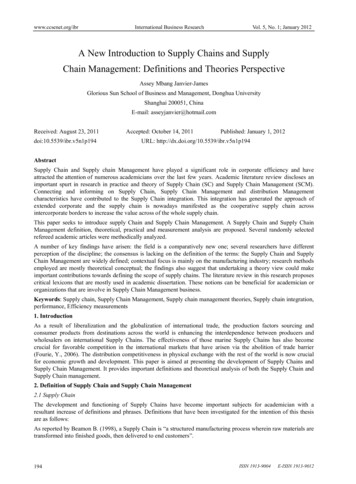
Transcription
REINVENTING THE SUPPLY CHAIN:THE FUTURE OFFULFILLMENTVISION STUDYCONFRONTING LOGISTICS CHALLENGES IN ANOMNICHANNEL SHOPPING LANDSCAPE
ZEBRA’S FUTURE OF FULFILLMENT VISION STUDYZebra Technologies commissioned a global research study to gain a richer understanding of howmanufacturers, retailers and logistics firms are preparing to meet the growing needs of the on-demandeconomy. Surveys were designed to reveal plans, implementation levels, experiences and attitudestoward omnichannel logistics.TOP TRENDSE-COMMERCE89% agreee-commerce isdriving the needfor faster delivery,spiking concern andinvestment2 zebra technologiesINVENTORYACCURACYDIGITIZATION OFTHE SUPPLY CHAINRespondentsestimate their currentinventories are55% of organizations66% accuratecurrently use penand paper to manageomnichannel logisticsINNOVATION61% say automationis disrupting theindustry
STATE OF THE INDUSTRYA 2.3 trillion global e-commerce market reflects how profoundly shopper expectations have recalibratedworldwide.1 Today’s consumers have been rewired by digital disruption. That always-connected, tech-savvyshopper expects a seamless, faster purchasing journey, whether she’s buying online and picking up in storeor wants her merchandise delivered in two hours to her door.In turn, a digital transformation is rippling through the retail supplychain, dictated by the moment-to-moment wants and whims ofconsumers forever changed by the Internet’s endless — andinstant — buying possibilities. The result is a retail ecosystem influx and it is shaking the supply chain at its very core.RESPONDENTS CHARACTERIZE THEIRORGANIZATION’S OMNICHANNEL STRATEGY3%NO PLANSNO PLANSOMNICHANNEL PLANIN PROCESSDIGITAL TRANSFORMATION OF THE SUPPLY CHAIN58%39%OPERATING ATOMNICHANNEL RTYLOGISTICS,WAREHOUSE,STORAGESTORE FRONTNON-STOREFRONTPHARMACYFASHION, APPAREL38%COMPUTER,ELECTRONICS29%CONSUMERPACKAGED GOODS,FOOD & BEVERAGE1Meeting shoppers’ omnichannel product delivery and fulfillmentexpectations calls for a digital transformation of the supply chainthat addresses key pain points. Inventory allocation, reducingbackorders and replenishment efficiency top the hurdles facinglogistics companies with omnichannel fulfillment, the study found.That comes as little surprise as merchants, manufacturers andlogistics firms navigate an ecosystem built for a single channelbrick-and-mortar shopping landscape, ones that are now taxed bya rapidly growing e-commerce market.To adapt, new business models are taking hold as the linesbetween retailers, manufacturers and logistics firms start to blur.These longtime, largely siloed, solo acts are increasingly actingin concert to rise to the demands of a dynamic, 24/7 bricks-andclicks shopping world.LOGISTICSPOSTAL, COURIER,FREIGHTTo succeed in the new normal, retailers, manufacturers andlogistics companies are collaborating and swapping rolesin uncharted ways to meet shoppers’ omnichannel productfulfillment and delivery expectations in a plot that is still unfolding.Companies are turning to digital technology and analyticsto bring heightened automation, merchandise visibility andbusiness intelligence to the supply chain to compete in theon-demand consumer economy. Although an estimated 73% ofconsumers are omnichannel shoppers today (and they spendmore than single-channel consumers),2 only 39% of supply chainrespondents believe they’re operating at an omnichannel level,the Zebra Technologies study revealed.NEW FULFILLMENT AND DELIVERY OPTIONSDramatic changes are beginning to materialize as industryplayers race to offer consumers fast, flexible and even freeproduct fulfillment and delivery. Consumers want a hassle-freeshopping trip whether they’re buying in-store, from their mobilephone, desktop computer or some combination of the three.Stores are increasingly doubling as distribution centers thatfulfill online orders. Logistics companies are starting to provideproduct fulfillment. Manufacturers are drop-shipping merchandiseto expedite retail deliveries. Retailers are also partnering withthird-party technology upstarts to handle last-mile delivery.EMarketer, Worldwide Retail and Ecommerce Sales: eMarketer’s Estimates for 2016–2021; 2 Harvard Business Review, A Study of 46,000 Shoppers Shows That Omnichannel Retailing Workszebra technologies3
THE OMNICHANNEL CHALLENGEE-commerce is growing at a staggering pace, projected to generate 4.479 trillion in retail sales by 2021,soaring over 140% from 1.859 trillion in 2016.3 And it’s forcing decision makers to shift to a robust omnichannelfulfillment strategy that meets the modern consumer’s needs.Today, 41% of consumersworldwide use two or morechannels during the purchaseprocess.4 According to Zebra’sof respondents agree10th annual shopper study,that the amount of51% of online shoppers shipcapital investmentto home, 35% pickup in storeand operatingand 29% ship to an alternateexpense requiredlocation. Accurately fulfillingfor omnichannel is athese orders 100% of the timechallengerequires inventory visibilityacross the entire supply chain.Unfortunately, inventory systems haven’t yet caught up and areunable to provide the level of inventory granularity necessaryto facilitate strong customer satisfaction. Survey respondents86%estimate that their inventories are about 66% accurate today.Clearly this level of preciseness is woefully inadequate in abuyer’s market where shopper tolerance of out of stocks, for one,is diminishing as countless alternatives are just a click away.Supply chain and operations leaders must swiftly adjust to thechanging world. The race is on to implement omnichannelprimed logistics systems and processes to ensure merchandisefulfillment is scalable as online sales volumes continueto escalate. But that’s a formidable task. Indeed, 86% ofrespondents cited the capital investment and operating costsof implementing an omnichannel operation as a challenge.Yet, companies must address this issue as more and moreconsumer’s physical and digital worlds are converging andthey are buying “phygitally.”RETAILERS AND MANUFACTURERS REPORT COMPLEX PURCHASING MODELSRETAILERSTODAY 2023MANUFACTURERS65%95%BUY IN STORE, SHIP FROM STORE TO HOME55%55%93%BUY ONLINE/MOBILE, PICK UP IN STORE49%BUY ONLINE/MOBILE,PICK UP AT THIRD-PARTY LOCATIONS36%88%45%90%88%91%52%98%BUY ONLINE/MOBILE, SHIP TO HOME42%89%55%96%BUY ONLINE/MOBILE, RETURN TO STORE38%87%BUY IN STORE, RETURN BY MAIL WITHRETURN LABEL FROM VENDOR WEBSITE37%87%45%93%INVENTORY ACCURACYTRANSPORTATION & LOGISTICS69%79%MANUFACTURING66%HOW ACCURATE ARE YOURINVENTORIES TODAY?376%65%73%HOW ACCURATE DO THEY NEED TO BE TO HANDLETHE RISE OF OMNICHANNEL LOGISTICS?EMarketer, Worldwide Retail and Ecommerce Sales: eMarketer’s Estimates for 2016–2021; 4 ForeSee, Foresee Experience Index: Retail CX Rankings4 zebra technologiesRETAIL
TURNING STORES INTO FULFILLMENT CENTERS91%AGREE MORE ANDMORE RETAILERSWILL CONTINUE TOTURN STORES INTOFULFILLMENT CENTERS86%AGREE CLICK ANDCOLLECT (BUY ONLINE/PICK UP IN STORE) WILLBECOME THE DEFAULTDELIVERY METHOD76%OF RETAILERSSURVEYED USE STOREINVENTORY TO FULFILLORDERS68%EXPECT STORE USE OFINVENTORY TO FULFILLORDERS TO GROW INTHE NEXT FIVE YEARSCHANGING ROLES AND INCREASING COLLABORATIONA new phenomenon is occurring in the retail sector as it shifts to serve its omnichannel consumer base.In a quest to boost online fulfillment performance and get their digital-physical profit model right, retailersare leveraging one of their greatest assets: their fleet of stores. At the same time, manufacturers are updatingtheir systems to accommodate both bulk and SKU-level shipping so that they too can serve consumers directly.Merchants are diving into “ship from store,” retrofitting locationsto double as online fulfillment centers and shrinking selling spaceto accommodate e-commerce pickups and returns. The studyrevealed that 76% of retailers use store inventory to fill onlineorders, and six out of 10 expect that to grow. In fact, some of thebiggest retailers now fill digital orders from every one of theirbrick-and-mortar locations.The strategy taps stores to fulfill digital purchases to defray thehigh transportation costs of online orders, which have beeneating into retail profit margins. By offering click and collect(buy online pickup in store) retailers skirt the cost of deliveringto shoppers’ homes, while encouraging add-on sales. That’sbecause consumers that come in to pick up their digital orderoften end up making impulse purchases.Industry leaders are also calculating that a network of stores canget digital orders faster and more efficiently to the consumerthan a handful of centralized warehouses. This is particularlycritical amid the growing consumer expectation for same dayand even two-hour delivery. Optimizing the distribution networkis key to omnichannel success.Meeting the unfolding demands of the omnichannel retaillandscape is also fostering newfound collaborations betweenmanufacturers and retailers. Suppliers are increasingly dropshipping merchandise directly to consumers for their retailpartners’ online operations. The study revealed that worldwide32% of retailers request drop ship from manufacturers and73% of manufacturers expect this to increase up to 10% over thenext five years.SHIPPING CAPABILITIES FOR IN-STORE AND ONLINE FULFILLMENT63%96%Stores enabled to fulfill web orders52%45%93%Direct ship from manufacturer or other retailer95%Stores enabled to ship to warehouse or directto consumers50%TODAY 202896%Stores enabled to transfer product betweenstore locations44%96%Dedicated fulfillment centers for online41%95%Shared fulfillment centers for online and offline40%93%Regional/near shoring of fulfillment centerszebra technologies5
90%90% of respondents agree that deliveryis an extension of a retailer’s brandTHE DELIVERY RESURGENCE: THE NEED FOR SPEEDE-commerce and an “I-want-it-now” instant-gratification mindset are feeding the consumer craving for fasterand faster delivery. Industry players are feverishly working to fulfill that demand and still turn a profit — achallenge given the high cost of transporting goods.EXPECTED DELIVERYWINDOW FOR FUTURESAME-DAY ORDERS32%2 hours or less44%3 to 4 hoursDecision makers are testing avast array of delivery strategiesto trim time, distance andcost from shipping orders.Retailers are offering curbsidepickup, warehouse pickup andmerchandise pickup at thirdparty locations such as parcelshops and lockers. And techstartups like Instacart, Qourierand UberRush have enteredthe fray to speed fulfillment.Solving the deliverychallenge has given rise to acrowdsourcing model wherebyretailers, manufacturers,24%5 hourslogistics companies and technology newbies are workingcollaboratively to get products in the hands of shoppers faster.That comes as little wonder, as some of the world’s biggestretailers are increasing their same-day delivery capabilitiesto compete with online retailing giants. Within five years, 78%of logistics companies surveyed expect to provide same-daydelivery and in 10 years 39% anticipate delivery within atwo-hour window.For brands, speed stokes loyalty among time-starvedshoppers. Today’s buyers have come to value companies thatoffer delivery perks such as the ability to track a purchaseand text notifications alerting them that their order “is justfour minutes away!” Importantly, more decision makers viewmerchandise delivery as an extension of the retailer’s brand inthe customer experience.EMERGING SHIPPING OPTIONS66%96%86%Semiautonomous Ground VehiclesDelivery person completesadministrative tasks whilevehicle does the driving6 zebra technologies91%49%Dedicated Delivery PersonDelivery service picks upparcels at a consolidation point27%TODAY 2028Store Fleet or Store StaffCar, bike, foot25%85%Autonomous Ground VehiclesParcels are delivered to athird-party location withouthuman intervention37%80%Bicycle CouriersA small number of parcelsdelivered by bicycle19%81%DronesAutonomous aircrafts carryparcels along the most directroute at a relatively high speed30%87%CrowdsourcingDriver network selectsa specific delivery order18%78%DroidsSmall autonomous vehiclesdeliver parcels via sidewalksrather than streets
TRENDS IN PRODUCT RETURNS70%30%46%52%PLAN TODISCONTINUEOFFER FREERETURN SHIPPINGADD A SURCHARGEFOR RETURNS45%50%PLAN TODISCONTINUEPLAN TODISCONTINUEHAVE A RETURNS FACILITYMANAGED BY A THIRD PARTYGRAPPLING WITH RETURNSThe rising consumer demand for free and fast product delivery correlates with a surge in product returns.Fulfillment and returns go hand in hand; they represent the two halves of the supply chain. While fulfillmentmeans bringing products to market, returns flow the product in reverse back through the supply chain.87%of respondents agreeaccepting and managingreturns is a challenge55%of retailers plan to employthird-party facilities tomanage returnsHandling product returns is nota new challenge for retailersand brands, but it’s become aninfinitely bigger concern in anomnichannel marketplace. It isalso extraordinarily costly andis eating into already pressuredprofit margins: Worldwide,shoppers return an estimated 642.6 billion in goodseach year.5Managing returns efficientlyand cost effectively is achallenge that retailers must take on. Shoppers increasinglyexpect free returns, and a hassle-heavy return process turns off80% of shoppers, according to a ComScore Study.6Still, reverse logistics capabilities remain underdeveloped andsignificant opportunities for improvement remain, the Zebrastudy revealed. Many retailers seem uncertain as to how toimprove their processes. In fact, 68% of surveyed retailers agreethat returns for online orders are a challenge with two out of 10viewing it as a significant challenge.Merchants are increasingly exploring new models to offsetthe costs of returns. The study uncovered that 52% of retailrespondents add a surcharge for returns today and 54% have noplans to change this in the future. Of the 48% of merchants thatdo not currently add a surcharge for returns, more than half planto do so in the future.Decision makers are testing solutions such as leveraging thestore as a product returns hub. A resounding 70% of surveyedexecutives agree that more retailers will turn stores intofulfillment centers that accommodate product returns. Accordingto the study, the majority of retailers that currently do not offerfree shipping, free returns or same-day delivery plan to do soand expect to engage third-party firms to manage the returnsprocess in the future.68% of retailers globally ranked returns ofonline orders as a challengeBY REGION83%LATIN AMERICA574%ASIA PACIFIC66%EUROPE51%NORTH AMERICAMarketWatch, Consumers Return 642.6 Billion in Goods Each Year ; 6 RetailNext, The Real Cost of Returns for Retailerszebra technologies7
ENABLING INTELLIGENT FULFILLMENTSupply chain decision makers worldwide are investing in an array of tools to streamline omnichannelmerchandise fulfillment. Solutions range from edge technologies – which automate worker tasks such aspicking and sorting merchandise at a distribution center – to demand forecasting and planning applicationsthat boost the accuracy of revenue forecasts and better align inventory levels via data analytics.In two to three years, tablets and handheld mobile computerswith barcode scanners will top the devices used for omnichannellogistics. The shift marks an upgrade from manual systems,such as pen and paper spreadsheets for inventory validation,to handheld mobile devices that offer real-time access towarehouse management systems.MOVING FROM MANUAL TO DIGITALTODAY 202864%97% 33%HANDHELD COMPUTERS WITH BUILT-IN BARCODE SCANNERS59%97% 38%HANDHELD BARCODE SCANNERS55%95% 40%TABLETS49%Additionally, demand forecasting and planning as well asworkforce management tools are being implemented today by50% of logistics companies surveyed. What’s more, workforcemanagement technologies will also see a rise in investments inthe next year by 32% of the same firms. 46%BARCODE LABEL, THERMAL PRINTERSTODAYDemand forecast planning93% 49%WEARABLE MOBILE COMPUTERS36%91% 55%VEHICLE-MOUNTED MOBILE COMPUTER33% 58%RFID-BASED INVENTORY MANAGEMENT tion management system45%97%Warehouse management system44%97%Tracking and event management41%96%Inventory planning and management40%97%Route optimization and scheduling39%97%Sensors and monitoring37%96%Network optimization system37%97%Electronic interfaces with carriers36%98%Electronic interfaces with shippers35%98%Yard management system34%94%Labor workforce management44%8 zebra technologiesMeanwhile, radio-frequency identification (RFID) technology andinventory management platforms are expected to grow the mostin the next few years. RFID-enabled software, hardware andtagging solutions offer up-to-the-minute, item-level inventorylookup, heightening inventory accuracy while reducing out ofstocks, overstocks and replenishment errors.WORKFORCE MANAGEMENT TOOLS ON THE RISE95%91%Not surprisingly, supply chain executives are outfitting workerswith mobile computers that enable quick, automated inventoryand cycle counting. They also grant them on-demand inventorylookup and product information to fulfill orders no matter wherea shopper purchase originates — a physical store or a smart phone — from wherever the inventory resides — in the retailstock room, fulfillment center at the manufacturer or on a deliverytruck. This in-the-moment inventory visibility enables nimbleomnichannel order fulfillment from any link in the supply chain.Freight document handling and archiving
EXPECTED REWARDS FROM TECHNOLOGY INVESTMENTS1Lower supply chainmanagement risks2Improved transport routing,transport mode selection3Reduced labor coststhrough automation4Shorter delivery times withoutincreasing inventoriesNEXT-GENERATION SUPPLY CHAIN TECHNOLOGIESIn the digital economy, manual processes left over from the pre-Internet era continue to vanish from warehouseand fulfillment operations. Decision makers looking to the future said next-generation supply chains will reflectconnected, business-intelligence and automated solutions suited to the on-demand, omnichannel landscape.E-commerce has given way to a dramatic rise in distributioncenters and warehousing operations placing enormous pressureon the already scarce supply of skilled labor resources. Tocounteract the labor concerns, supply chain decision makersare forecasting that automation will offset the shortages. Surveyexecutives identified the most highly disruptive technologies asdrones, driverless/autonomous vehicles and augmented reality.Next-generation supply chains will utilize robotics andautomation to perform traditionally manual tasks such as picking,sorting, inspecting, storing, handling and classifying productsto improve overall efficiency, worker productivity and speed tomarket. Some warehouses are turning to autonomous vehiclesto bring merchandise to sortation and packing areas. Othersare using drones and RFID for inventory management. Theopportunities are seemingly limitless and include wearabletechnology, which enables truly hands-free, multi-modalworkflows that result in greater worker efficiency and increasedproductivity. The market for enterprise wearable devices isexpected to skyrocket with projected growth of 75% by 2021.7Interestingly, while supply chain executives have highlightedkey disruptors, they seem to be taking a wait-and-see approachwhen it comes to actually investing. Indeed, these technologiesare being implemented more as tests to determine their returnon investment rather than a full-scale rollout.Industry players also face the challenge of managing thesenext-generation technologies across the many moving parts ofthe supply chain for an effective omnichannel strategy, whileimplementing them to work seamlessly with existing legacysystems — which is no easy feat.TRANSFORMATIVE TECHNOLOGY DISRUPTORSPENETRATION LEVELEARLY-STAGE DISRUPTORSADVANCING DISRUPTORSMAINSTREAM DISRUPTORSAUTONOMOUS VEHICLESDRONES/ROBOTSAUGMENTED REALITYWEARABLE MOBILE TECHNOLOGYMACHINE LEARNINGDIGITAL SECURITYPREDICTIVE ANALYTICS3D PRINTINGINTERNET OF THINGSNEW TECHNOLOGY IMPLEMENTATION CHALLENGESDIFFICULTY IN DEPLOYING, INTEGRATINGAND MANAGING NEW TECHNOLOGY7INTERNAL COORDINATIONSTRATEGYDETERMINING ROI OFNEW TECHNOLOGYSAFETY ANDTRAININGREGULATORYREQUIREMENTSFung Global Retail & Techzebra technologies9
REGIONAL FINDINGSIndustry decision makers worldwide view the growing omnichannel landscape as driving the need formerchandise delivery and fulfillment processes upgraded by digitally-enabled automation, merchandisevisibility and business intelligence. But their areas of need and focus vary by region.85%rank drones as oneof the most disruptivetechnologiesASIA PACIFICIn Asia Pacific, 95% of respondents rated e-commerce as the driving need forfaster delivery. The region expects to implement same day delivery faster thanany other continent and nearly 30% consider returns for online orders as asignificant challenge. Drones were ranked by 85% of those surveyed as one ofthe most important disruptive technologies.EUROPEEuropean retailers are increasingly turning to separate facilities to handleonline orders and returns. Currently, 52% of merchants surveyed employthird-party logistics firms to handle the complex task of returns. By 2028,dedicated fulfillment centers are expected to grow by over 110% with 93%of retailers planning to employ them for online orders. A clear majority ofrespondents (68%) view digital security as a disruptive technology.93%agree pressure toreduce environmentalimpact is growingof retailers employthird-party logistics firmsto handle returnsLATIN AMERICAIn Latin America, 93% of executives agreed that they are facing increasingpressure to reduce the environmental impact of e-commerce caused by reliance onpaper-based systems and the surge in the number of delivery vehicles. The regionis embracing RFID solutions to enable omnichannel logistics more dramaticallythan most regions with respondents expecting penetration rates to skyrocket by2028 for active RFID (95%), Infrared RFID (91%) and passive RFID (86%).NORTH AMERICAIn the United States and Canada, manufacturers, logistics companies andmerchants ranked current inventory accuracy at 74% and reported needing tobe at 83% to handle the rise of omnichannel logistics. Only 44% of companiesprovide same-day service today trailing all other regions. A resounding 83%classified driverless/autonomous vehicles as disruptive to the industry.10 zebra technologies52%83%classifiedautonomous vehiclesas highly disruptive
ABOUT THE STUDYRESPONDENTS BY GEOGRAPHY26%27%NORTH AMERICAEUROPE(Canada, United States)(France, Germany, Italy, Russia,Spain, United Kingdom)22%26%LATIN AMERICAASIA PACIFIC(Brazil, Chile,Colombia, Mexico)(Australia, China,India, New Zealand)BY 9%MANUFACTURINGBY REVENUE 250 MILLION TO 500 MILLION18%9%13%TRANSPORTATIONE-COMMERCEAND ONLINESELLINGPOST ANDPARCELDELIVERY101 TO 50013%18%12%13%19%33%1,001 TO 5,00017% 5 BILLION TO 50 BILLION 50 BILLION 4%501 TO 1,000 500 MILLION TO 1 BILLION 1 BILLION TO 5 BILLION15%BY NUMBER OF EMPLOYEES 1 MILLION TO 100 MILLION 100 MILLION TO 250 MILLION15%5,001 TO 10,00015%10,001 TO 50,0007%50,001 TO 100,000100,000 8%4%zebra technologies11
GEARING UP FORNEXT-GENERATION SUPPLY CHAINSSurviving and thriving amid the global, digital shopping revolution, in which consumers fluidlybrowse and buy from their smartphones, computers and in store, calls for a supply-chain makeover.Pressed to offer consumers fast, flexible and even free product fulfillment and deliveryin an omnichannel retail landscape, a crowdsourced, collaborative model is taking shape.Traditional roles are blurring as logistics companies, manufacturers and retailers work to meet thegrowing on-demand economy via the adoption of business-intelligence supply chain technologies.In turn, stores are increasingly doubling as distribution centers that fulfill online orders;logistic companies are starting to provide fulfillment and distribution services; andmanufacturers are drop-shipping merchandise to expedite retail deliveries. Merchantsare also partnering with third-party technology upstarts to speed last-mile delivery.These next-generation supply chain systems and practices are designed to ensurethat merchandise fulfillment is scalable in an omnichannel marketplace.ABOUT ZEBRA TECHNOLOGIESZebra provides unparalleled operational visibility to give enterprisesthe digital edge they require to thrive in an omnichannel landscape.For more information, please visit us on the web.Transportation and Logistics: www.zebra.com/tlManufacturing: www.zebra.com/manufacturingRetail: www.zebra.com/retailNA and Corporate Headquarters 1 800 423 0442inquiry4@zebra.comAsia-Pacific Headquarters 65 6858 0722contact.apac@zebra.comEMEA comLatin America Headquarters 1 847 955 2283la.contactme@zebra.com 2018 ZIH Corp and/or its affiliates. All rights reserved. ZEBRA and the stylized Zebra head are trademarks of ZIH Corp, registered in many jurisdictionsworldwide. All other trademarks are the property of their respective owners.
Dedicated fulfillment centers for online Shared fulfillment centers for online and offline Regional/near shoring of fulfillment centers A new phenomenon is occurring in the retail sector as it shifts to serve its omnichannel consumer base. In a quest to boost online fulfillment performance and get their digital-physical profit model right .











